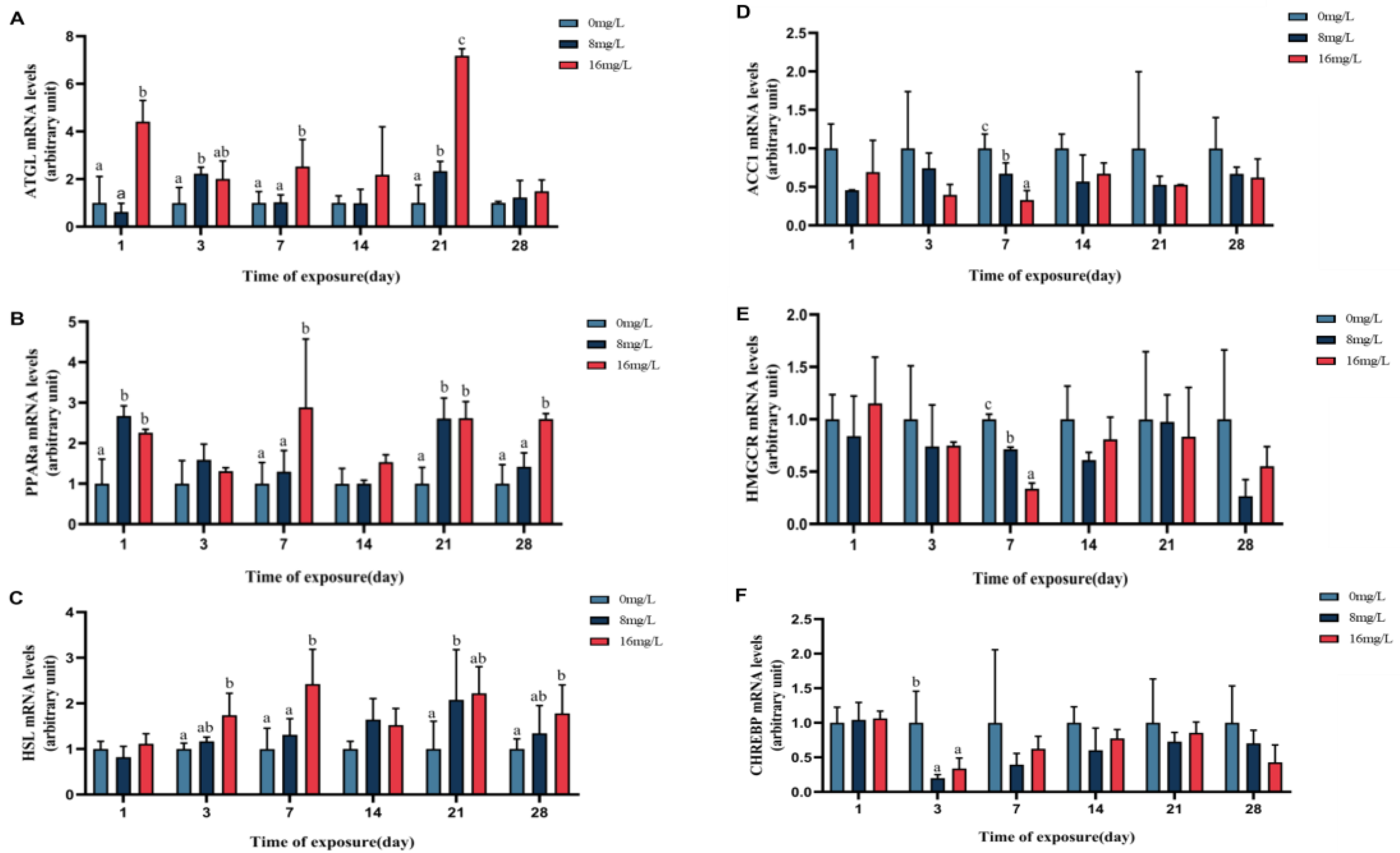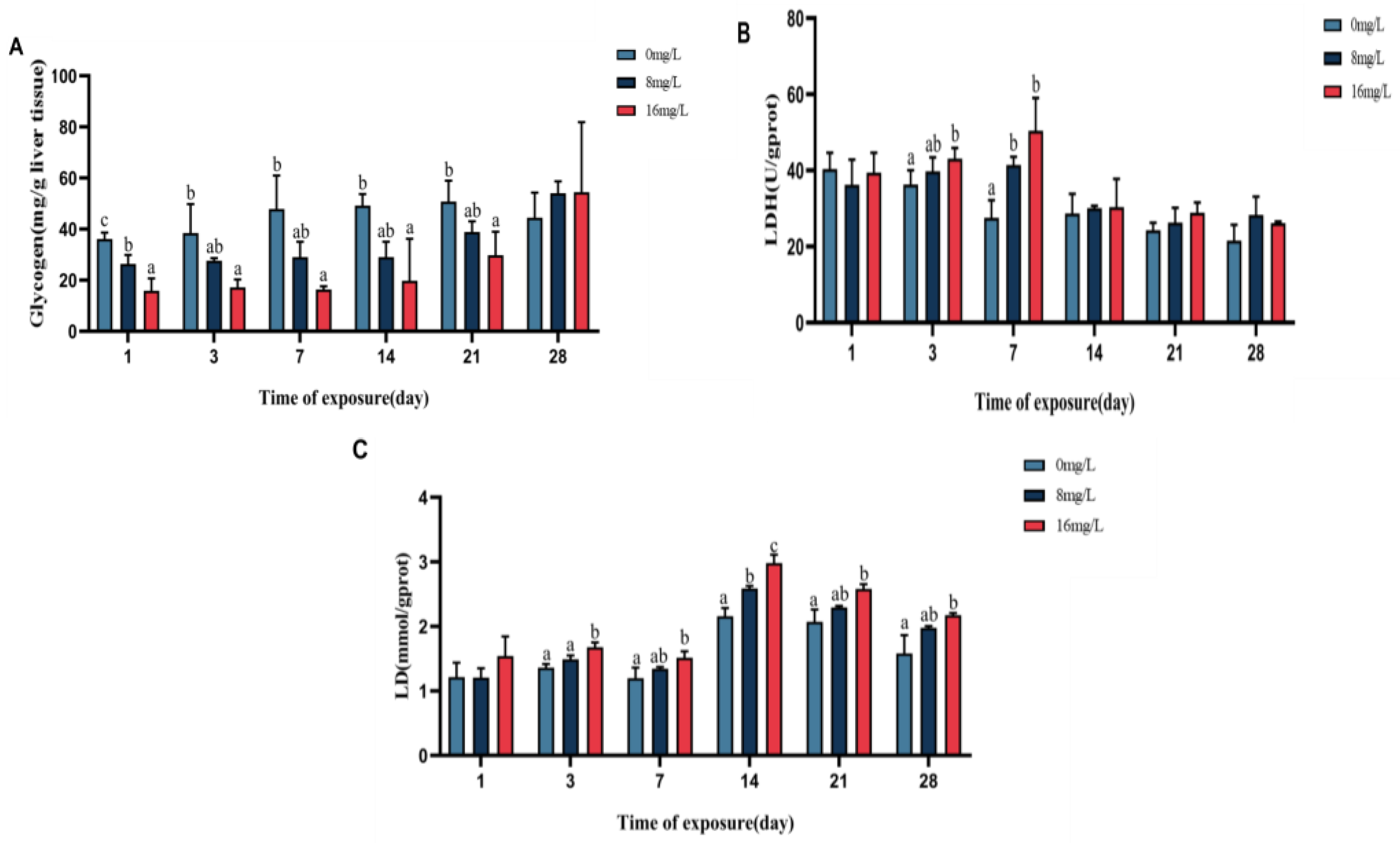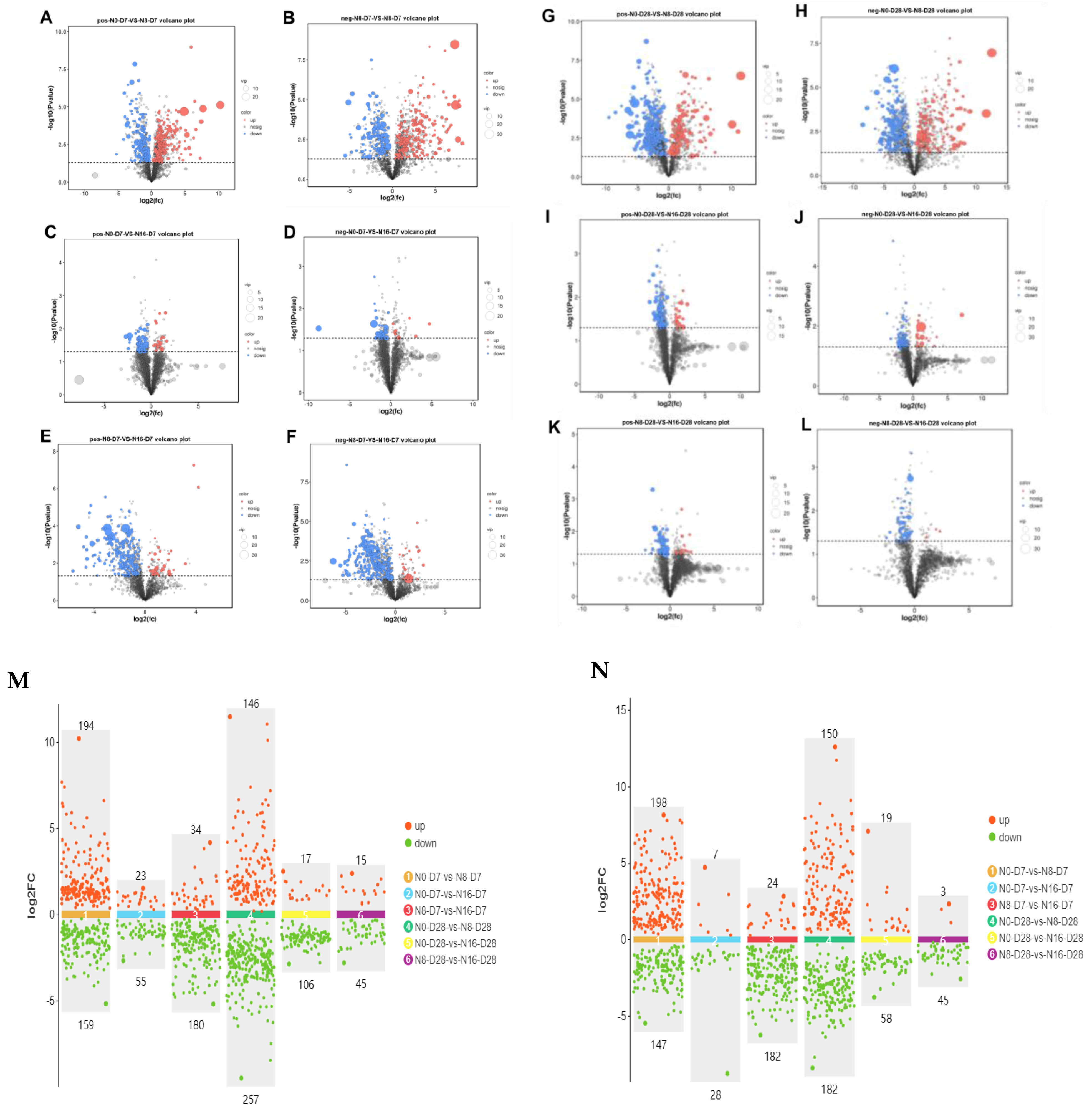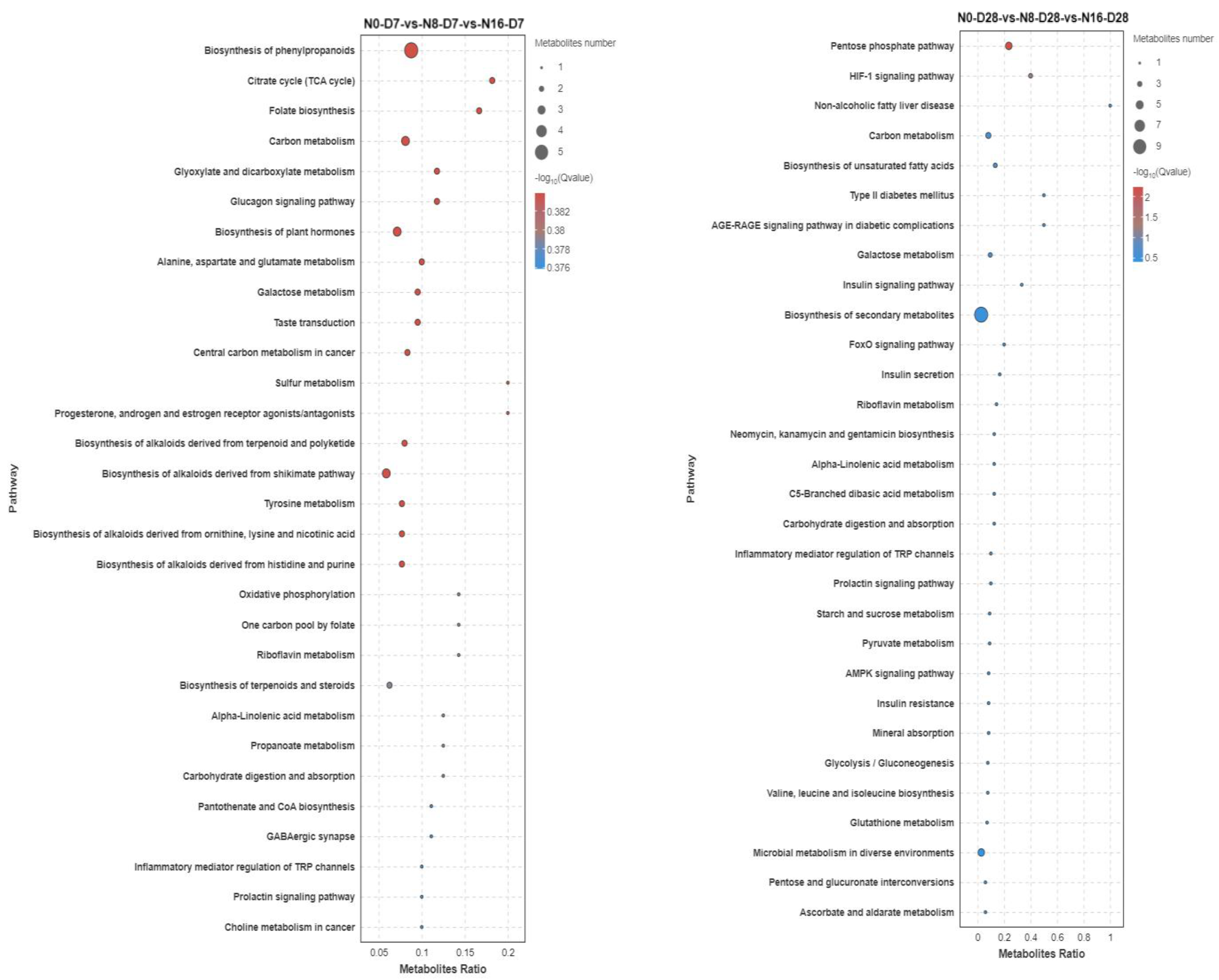Effects of Nitrite Stress on Growth, Glycolipid Metabolism, and Hepatic Metabolome in Spotted Seabass (Lateolabrax maculatus) Under High-Temperature Conditions
Simple Summary
Abstract
1. Introduction
2. Materials and Methods
2.1. Nitrite Stress Experiment
2.2. Feeding Management
2.3. Sample Collection
2.4. Chemical Composition
2.5. Biochemistry Analyses
2.6. Expression of Genes Involved in Hepatic Glycolipid Metabolism
2.7. Metabolomics
2.8. Statistical Analysis
3. Results
3.1. Growth Performance
3.2. Body Composition and Morphological Parameters
3.3. Serum Biochemical Indicators
3.4. Liver Biochemical Indicators
3.5. Relative Expression of Lipid Metabolism Genes in Liver
3.6. Glucose Metabolism-Related Indicators in Liver
3.7. Metabolomics Analysis
4. Discussion
5. Conclusions
Author Contributions
Funding
Institutional Review Board Statement
Informed Consent Statement
Data Availability Statement
Conflicts of Interest
References
- Yun, H.J.; Kim, D.J. Nitrite accumulation characteristics of high strength ammonia wastewater in an autotrophic nitrifying biofilm reactor. J. Chem. Technol. Biotechnol. 2003, 78, 377–383. [Google Scholar] [CrossRef]
- Sun, X.; Frey, C.; Ward, B.B. Nitrite oxidation across the full oxygen spectrum in the ocean. Glob. Biogeochem. Cycles 2023, 4, 37. [Google Scholar] [CrossRef]
- Kroupová, H.K.; Valentová, O.; Svobodová, Z.; Šauer, P.; Máchová, J. Toxic effects of nitrite on freshwater organisms: A review. Rev. Aquacult. 2016, 10, 525–542. [Google Scholar] [CrossRef]
- Rodgers, E.M.; Boeck, G.D. Nitrite-induced reductions in heat tolerance are independent of aerobic scope in a freshwater teleost. J. Exp. Biol. 2019, 23, 212035. [Google Scholar]
- Pottinger, T.G. Modulation of the stress response in wild fish is associated with variation in dissolved nitrate and nitrite. Environ. Pollut. 2017, 225, 550–558. [Google Scholar] [CrossRef][Green Version]
- Ciji, A.; Akhtar, M.S. Nitrite implications and its management strategies in aquaculture: A review. Rev. Aquac. 2020, 12, 878–908. [Google Scholar] [CrossRef]
- Ortiz, W.E.; Carlos-Shanley, C.; Huertas, M. Impact of sublethal concentrations of nitrite on goldfish (Carassius auratus) microbiomes. Microb. Ecol. 2023, 86, 1331–1342. [Google Scholar] [CrossRef]
- Li, X.; Li, J.; Lu, K.L.; Li, X.S.; Song, K.; Wang, L.; Zhang, C.X. Effect of dietary supplementation of selenium-L-methionine on growth, antioxidant capacity and resistance to nitrite stress of spotted seabass (Lateolabrax maculatus) under two rearing water temperatures. Anim. Nutr. 2024, 19, 166–179. [Google Scholar] [CrossRef]
- Huong, D.; Gam, L.; Lek, S.; Ut, V.N.; Phuong, N.T. Effects of nitrite at different temperatures on physiological parameters and growth in clown knifefish (Chitala ornata, Gray 1831). Aquaculture 2020, 521, 735060. [Google Scholar] [CrossRef]
- Zhang, J.; Chen, J.; Liang, H.; Li, M.; Zhou, W.H.; Yang, Y.L.; Zhang, Z.; Ding, Q.W.; Ran, C.; Zhou, Z.G. Effect of crowding stress on liver health, gut permeability and gut microbiota of genetically improved farmed tilapia (GIFT, Oreochromis niloticus). Aquaculture 2025, 594, 741448. [Google Scholar] [CrossRef]
- Zhang, J.; Yu, M.H.; Wang, J.; Longshaw, M.; Song, K.; Wang, L.; Li, X.S.; Zhang, C.X.; Lu, K.L. Methanotroph (Methylococcus capsulatus, Bath) bacteria meal alleviates soybean meal-induced enteritis in spotted seabass (Lateolabrax maculatus) by modulating immune responses and the intestinal flora. Aquaculture 2023, 575, 739195. [Google Scholar] [CrossRef]
- Yang, X.; Wang, L.; Lu, K.L.; Li, X.S.; Song, K.; Zhang, C.X. High temperature induces oxidative stress in spotted seabass (Lateolabrax maculatus) and leads to inflammation and apoptosis. Fish Shellfish Immunol. 2024, 154, 109913. [Google Scholar] [CrossRef] [PubMed]
- Cai, L.S.; Wang, L.; Song, K.; Lu, K.L.; Zhang, C.X.; Rahimnejad, S. Evaluation of protein requirement of spotted seabass (Lateolabrax maculatus) under two temperatures, and the liver transcriptome response to thermal stress. Aquaculture 2020, 516, 734615. [Google Scholar] [CrossRef]
- Siikavuopio, S.I.; Sæther, B.S. Effects of chronic nitrite exposure on growth in juvenile Atlantic cod, Gadus morhua. Aquaculture 2006, 255, 351–356. [Google Scholar] [CrossRef]
- Yang, X.; Weng, Q.J.; Li, X.S.; Lu, K.L.; Wang, L.; Song, K.; Zhang, C.X.; Rahimnejad, S. High water temperature raised the requirements of methionine for spotted seabass (Lateolabrax maculatus). Fish Physiol. Biochem. 2024, 50, 23–40. [Google Scholar] [CrossRef]
- Shen, C.; Cao, S.; Mohsen, M.; Li, X.S.; Wang, L.; Lu, K.L.; Zhang, C.X.; Song, K. Effects of chronic nitrite exposure on hematological parameters, oxidative stress and apoptosis in spotted seabass (Lateolabrax maculatus) reared at high temperature. Aquac. Rep. 2024, 35, 102022. [Google Scholar] [CrossRef]
- Zhang, J.M.; Fu, B.; Li, Y.C.; Sun, J.H.; Xie, J.; Wang, G.J.; Tian, J.J.; Kaneko, G.; Yu, E.M. The effect of nitrite and nitrate treatment on growth performance, nutritional composition and flavor-associated metabolites of grass carp (Ctenopharyngodon idella). Aquaculture 2023, 562, 741448. [Google Scholar] [CrossRef]
- Mubarik, M.S.; Ismail, A.; Hussain, S.M.; Jabeen, F.; Samiullah, K.; Yaqub, S.; Ahmad, S.; Feroz, K.; Khan, M.T.; Nazli, S.; et al. Survival, growth and body composition of Cprinus carpiounder different levels of temperature and salinity. Saudi J. Biol. Sci. 2015, 6, 132–141. [Google Scholar]
- Xie, L.X.; Chen, S.Q.; Yao, C.R.; Li, D.P.; Li, L.; Tang, R. Nitrite induces endoplasmic reticulum stress and associates apoptosis of liver cells in grass carp (Ctenopharyngodon idella). Aquaculture 2019, 507, 275–281. [Google Scholar] [CrossRef]
- Xia, T.; Mao, X.J.; Zhang, J.; Rahimnejad, S.; Lu, K.L. Effects of quercetin and hydroxytyrosol supplementation in a high-fat diet on growth, lipid metabolism, and mitochondrial function in spotted seabass (Lateolabrax maculatus). Aquaculture 2024, 582, 740538. [Google Scholar] [CrossRef]
- Chen, J.; Zhang, J.; Xie, M.X.; Hao, Q.; Liang, H.; Li, M.; Zhou, W.H.; Zhang, Z.; Ran, C.; Zhou, Z.G. The effect of dietary supplementation with Lactobacillus rhamnosus GCC-3 fermentation product on gut and liver health of common carp (Cyprinus carpio). Aquac. Rep. 2024, 35, 101983. [Google Scholar] [CrossRef]
- Wang, S.; Chen, X.; Zhang, W.; He, S.; Chen, D. Expression of peroxisome proliferator-activated receptor alpha in human normal liver and hepatocellular carcinoma. Chin. J. Hepatol. 2004, 12, 52–53. [Google Scholar]
- Yang, X.; Wang, L.; Lu, K.L.; Li, X.S.; Song, K.; Zhang, C.X. High temperature changes the structure and function of spotted seabass (Lateolabrax maculatus) tissues and causes ER stress and mitochondrial homeostasis imbalance in liver. Aquaculture 2025, 599, 742107. [Google Scholar] [CrossRef]
- Cheng, T.; Chen, J.D.; Dong, X.H.; Yang, Q.H.; Liu, H.Y.; Zhang, S.; Xie, S.W.; Zhang, W.; Deng, J.M.; Tan, B.P.; et al. Protective effect of steroidal saponins on heat stress in the liver of largemouth bass (Micropterus salmoides) revealed by metabolomic analysis. Aquac. Rep. 2023, 33, 101875. [Google Scholar] [CrossRef]
- Dong, Y.Z.; Li, L.; Xia, T.; Wang, L.N.; Xiao, L.P.; Ding, N.S.; Wu, Y.L.; Lu, K.L. Oxidative stress can be attenuated by 4-pba caused by high-fat or ammonia nitrogen in cultured spotted seabass: The mechanism is related to endoplasmic reticulum stress. Antioxidants 2022, 11, 1276. [Google Scholar] [CrossRef]
- Ha, N.; Huong, D.; Phuong, N.T.; Bayley, M.; Jensen, F.B. Impact and tissue metabolism of nitrite at two acclimation temperatures in striped catfish (Pangasianodon hypophthalmus). Aquat. Toxicol. 2019, 212, 154–161. [Google Scholar] [CrossRef]
- AOAC. Official Methods of Analysis of the Association of Analytical Chemistry, 17th ed.; Association of Official Analytical Chemists: Washington, DC, USA, 2003. [Google Scholar]
- Hussain, S.M.; Sharif, A.; Bashir, F.; Ali, S.; Javid, A.; Hussain, A.I.; Ghafoor, A.; Alshehri, M.A.; Naeem, A.; Naeem, E.; et al. Polymerase Chain Reaction: A Toolbox for Molecular Discovery. Mol. Biotechnol. 2025. [CrossRef]
- Roveda, M.; de Menezes, C.; Bolívar-Ramírez, N.C.; Owatari, M.S.; Jatobá, A. Acidifying remediation and microbial bioremediation decrease ammoniacal nitrogen, orthophosphates, and total suspended solids levels in intensive Nile tilapia farming under biofloc conditions. Aquaculture 2024, 580, 740292. [Google Scholar] [CrossRef]
- Xu, Z.K.; Zhang, H.Z.; Guo, M.J.; Fang, D.; Mei, J.; Xie, J. Analysis of acute nitrite exposure on physiological stress response, oxidative stress, gill tissue morphology and immune response of large yellow croaker (Larimichthys crocea). Animals 2022, 12, 1791. [Google Scholar] [CrossRef]
- Ciji, A.; Sahu, N.P.; Pal, A.K.; Akhtar, M.S. Physiological changes in Labeo rohita during nitrite exposure: Detoxification through dietary vitamin E. Comp. Biochem. Physiol. Part C Toxicol. Pharmacol. 2013, 158, 122–129. [Google Scholar] [CrossRef]
- Kroupova, H.; Machova, J.; Piackova, V.; Blahova, J.; Dobsikova, R.; Novotny, L.; Svobodova, Z. Effects of subchronic nitrite exposure on rainbow trout (Oncorhynchus mykiss). Ecotoxicol. Environ. Saf. 2008, 71, 813–820. [Google Scholar] [CrossRef] [PubMed]
- Duan, Y.F.; Zhong, G.W.; Xiao, M.; Yang, Y.K.; Wang, Y.; Nan, Y.X. Integrated physiological, energy metabolism, and metabonomic responses indicate the stress response in the hepatopancreas of Litopenaeus vannamei to nitrite stress. Aquat. Toxicol. 2024, 277, 107164. [Google Scholar] [CrossRef] [PubMed]
- Chen, Q.Y.; Zheng, X.T.; Kumar, V.; Liang, X.Y.; Dong, H.B.; Huang, J.H.; Zhang, J.S. Effects of nitrite exposure on biochemical parameters and liver histopathology in American bullfrogs (Aquarana catesbeiana). Aquac. Int. 2024, 32, 9873–9889. [Google Scholar] [CrossRef]
- Li, Z.S.; Ma, S.; Shan, H.W.; Wang, T.; Xiao, W. Responses of hemocyanin and energy metabolism to acute nitrite stress in juveniles of the shrimp Litopenaeus vannamei. Ecotoxicol. Environ. Saf. 2019, 186, 109753. [Google Scholar] [CrossRef]
- Xiao, J.; Luo, S.S.; Du, J.H.; Liu, Q.Y.; Huang, Y.; Wang, W.F.; Chen, X.L.; Chen, X.H.; Liu, H.; Zhou, X.Y.; et al. Transcriptomic analysis of gills in nitrite-tolerant and -sensitive families of Litopenaeus vannamei. Comp. Biochem. Physiol. C Toxicol. Pharmacol. 2022, 253, 7182. [Google Scholar] [CrossRef]
- Yan, H.J.; Zhao, Z.Y.; Li, W.S. Nitrite exposure leads to glycolipid metabolic disorder via the heme-HO pathway in teleost. Ecotoxicol. Environ. Saf. 2024, 281, 116653. [Google Scholar] [CrossRef]
- Yang, H.; Ou-Yang, K.; He, Y.; Wang, X.Y.; Wang, L.M.; Yang, Q.; Li, D.P.; Li, L. Nitrite induces hepatic glucose and lipid metabolism disorders in zebrafish through mitochondrial dysfunction and ERs response. Aquat. Toxicol. 2024, 273, 107015. [Google Scholar] [CrossRef]
- Gao, X.Q.; Fei, F.; Huo, H.H.; Huang, B.; Meng, X.S.; Zhang, T.; Liu, B.L. Effect of acute exposure to nitrite on physiological parameters, oxidative stress, and apoptosis in Takifugu rubripes. Ecotoxicol. Environ. Saf. 2020, 188, 109871. [Google Scholar] [CrossRef]
- Jia, R.; Han, C.; Lei, J.L.; Liu, B.L.; Huang, B.; Huo, H.H.; Yin, S.T. Effects of nitrite exposure on haematological parameters, oxidative stress and apoptosis in juvenile turbot (Scophthalmus maximus). Aquat. Toxicol. 2015, 169, 1–9. [Google Scholar] [CrossRef]
- Zhang, M.Z.; Yin, X.L.; Li, M.; Wang, R.X.; Qian, Y.X.; Hong, M.L. Effect of nitrite exposure on haematological status, oxidative stress, immune response and apoptosis in yellow catfish (Pelteobagrus fulvidraco). Comp. Biochem. Physiol. C Toxicol. Pharmacol. 2020, 238, 108867. [Google Scholar] [CrossRef]
- Li, X.; Han, T.; Zheng, S.; Wu, G. Hepatic glucose metabolism and its disorders in fish. Adv. Exp. Med. Biol. 2022, 1354, 207–236. [Google Scholar]
- Horton, J.D.; Goldstein, J.L.; Brown, M.S. SREBPs: Activators of the complete program of cholesterol and fatty acid synthesis in the liver. J. Clin. Investig. 2002, 109, 1125–1131. [Google Scholar] [CrossRef] [PubMed]
- VidalPuig, A.; JimenezLinan, M.; Lowell, B.B.; Hamann, A.; Hu, E.; Spiegelman, B.; Flier, J.S.; Moller, D.E. Regulation of PPAR gamma gene expression by nutrition and obesity in rodents. J. Clin. Investig. 1996, 97, 2553–2561. [Google Scholar] [CrossRef] [PubMed]
- Mouisel, E.; Bodon, A.; Noll, C.; Cassant-Sourdy, S.; Marques, M.A.; Flores-Flores, R.; Riant, E.; Bergoglio, C.; Vezin, P.; Caspar-Bauguil, S.; et al. Cold-induced thermogenesis requires neutral-lipase-mediated intracellular lipolysis in brown adipocytes. Cell Metab. 2025, 37, 429–440. [Google Scholar] [CrossRef]
- Hvas, M.; Damsgaard, C.; Gam, L.; Huong, D.; Jensen, F.B.; Bayley, M. The effect of environmental hypercapnia and size on nitrite toxicity in the striped catfish (Pangasianodon hypophthalmus). Aquat. Toxicol. 2016, 176, 151–160. [Google Scholar] [CrossRef]
- Walker, R.M.; Johansen, P.H. Anaerobic metabolism in goldfish (Carassius-Auratus). Can. J. Zool. 1977, 55, 1304–1311. [Google Scholar] [CrossRef]
- Jorgensen, J.B.; Mustafa, T. The effect of hypoxia on carbohydrate-metabolism in flounder (platichthys-flesus l). 1. utilization of glycogen and accumulation of glycolytic end products in various tissues. Comp. Biochem. Phys. B 1980, 67, 243–248. [Google Scholar] [CrossRef]
- Woo, N.; Wu, R. Changes in biochemical-composition in the red grouper, Epinephelus-Akaara (Temminck and Schlegel), and the black-sea bream, Mylio-Macrocephalus (Basilewsky), during hypoxic exposure. Comp. Biochem. Phys. A 1984, 77, 475–482. [Google Scholar] [CrossRef]
- Moraes, G.; Cattony, E.B.; Souza, R.H. Metabolic responses of the teleost hoplias malabaricus to high levels of environmental nitrite. Rev. Bras. Biol. 1998, 58, 105–113. [Google Scholar]
- Arillo, A.; Gaino, E.; Margiocco, C.; Mensi, P.; Schenone, G. Biochemical and ultrastructural effects of nitrite in rainbow-trout—Liver hypoxia as the root of the acute toxicity mechanism. Environ. Res. 1984, 34, 135–154. [Google Scholar] [CrossRef]
- Long, S.S.; Dong, X.H.; Tan, B.P.; Zhang, S.; Xie, S.W.; Yang, Q.H.; Chi, S.Y.; Liu, H.Y.; Deng, J.M.; Yang, Y.Z.; et al. Growth performance, antioxidant ability, biochemical index in serum, liver histology and hepatic metabolomics analysis of juvenile hybrid grouper (♀ Epinephelus fuscoguttatus x ♂ Epinephelus lanceolatus) fed with oxidized fish oil. Aquaculture 2021, 545, 737261. [Google Scholar] [CrossRef]
- Roques, S.; Deborde, C.; Richard, N.; Skiba-Cassy, S.; Moing, A.; Fauconneau, B. Metabolomics and fish nutrition: A review in the context of sustainable feed development. Rev. Aquac. 2020, 12, 261–282. [Google Scholar] [CrossRef]
- Daniel, P.V.; Dogra, S.; Rawat, P.; Choubey, A.; Khan, A.S.; Rajak, S.; Kamthan, M.; Mondal, P. NF-κB p65 regulates hepatic lipogenesis by promoting nuclear entry of ChREBP in response to a high carbohydrate diet. J. Biol. Chem. 2021, 296, 100714. [Google Scholar] [CrossRef] [PubMed]
- Das, P.C.; Ayyappan, S.; Das, B.K.; Jena, J.K. Nitrite toxicity in Indian major carps: Sublethal effect on selected enzymes in fingerlings of Catla catla, Labeo rohita and Cirrhinus mrigala. Comp. Biochem. Physiol. C Toxicol. Pharmacol. 2004, 138, 3–10. [Google Scholar] [CrossRef]
- Jensen, F.B.; Andersen, N.A.; Heisler, N. Effects of nitrite exposure on blood respiratory properties, acid-base and electrolyte regulation in the carp (cyprinus-carpio). J. Comp. Physiol. B 1987, 157, 533–541. [Google Scholar] [CrossRef]
- Kim, J.H.; Kim, J.Y.; Lim, L.J.; Kim, S.K.; Choi, H.S.; Hur, Y.B. Effects of waterborne nitrite on hematological parameters and stress indicators in olive flounders, Paralichthys olivaceus, raised in bio-floc and seawater. Chemosphere 2018, 209, 28–34. [Google Scholar] [CrossRef]
- Luo, S.; Wu, B.L.; Xiong, X.Q.; Wang, J.W. Short-term toxicity of ammonia, nitrite, and nitrate to early life stages of the rare minnow (Gobiocypris Rarus). Environ. Toxicol. Chem. 2016, 35, 1422–1427. [Google Scholar] [CrossRef]
- Moraes, G.; Avilez, I.M.; Hori, T.S.F. Comparison between biochemical responses of the teleost pacu and its hybrid tambacu (Piaractus mesopotamicus x Colossoma macropomum) to short-term nitrite exposure. Braz. J. Biol. 2006, 66, 1103–1108. [Google Scholar] [CrossRef]











| Target Genes | Forward (5′ to 3′) | Reverse (5′ to 3′) | Annealing Temperature (°C) |
|---|---|---|---|
| Acc1 | AAGGCGGTGGTGATGGATTT | GGCCATGTCGCCTTTGTTTT | 60 |
| Hmgcr | GACCGTGCATACGGAACAGA | AGTGTGTGGGTTGAGACCG | 60 |
| Chrebp | GTGACAACGCTCAGCTCTCA | TGATGGCAGAGTTCAGGAGC | 60 |
| Atgl | CTTCCTCTCCGCAACAAGTC | TGGTGCTGTCTGGAGTGTTC | 60 |
| Hsl | CGAAACACAGAGACGGTCCA | TCATGACATCTACCAGCCGC | 60 |
| Ppara | CCGTGCGTGTTTTCACCATT | AGACCAAATACATCGCCCCC | 60 |
| β-actin | CAACTGGGATGACATGGAGAAG | TTGGCTTTGGGGTTCAGG | 60 |
Disclaimer/Publisher’s Note: The statements, opinions and data contained in all publications are solely those of the individual author(s) and contributor(s) and not of MDPI and/or the editor(s). MDPI and/or the editor(s) disclaim responsibility for any injury to people or property resulting from any ideas, methods, instructions or products referred to in the content. |
© 2025 by the authors. Licensee MDPI, Basel, Switzerland. This article is an open access article distributed under the terms and conditions of the Creative Commons Attribution (CC BY) license (https://creativecommons.org/licenses/by/4.0/).
Share and Cite
Gao, J.; Cao, S.; Shen, C.; Zhang, J.; Wang, L.; Li, X.; Lu, K.; Zhang, C.; Song, K. Effects of Nitrite Stress on Growth, Glycolipid Metabolism, and Hepatic Metabolome in Spotted Seabass (Lateolabrax maculatus) Under High-Temperature Conditions. Animals 2025, 15, 1870. https://doi.org/10.3390/ani15131870
Gao J, Cao S, Shen C, Zhang J, Wang L, Li X, Lu K, Zhang C, Song K. Effects of Nitrite Stress on Growth, Glycolipid Metabolism, and Hepatic Metabolome in Spotted Seabass (Lateolabrax maculatus) Under High-Temperature Conditions. Animals. 2025; 15(13):1870. https://doi.org/10.3390/ani15131870
Chicago/Turabian StyleGao, Juan, Shi Cao, Chen Shen, Jian Zhang, Ling Wang, Xueshan Li, Kangle Lu, Chunxiao Zhang, and Kai Song. 2025. "Effects of Nitrite Stress on Growth, Glycolipid Metabolism, and Hepatic Metabolome in Spotted Seabass (Lateolabrax maculatus) Under High-Temperature Conditions" Animals 15, no. 13: 1870. https://doi.org/10.3390/ani15131870
APA StyleGao, J., Cao, S., Shen, C., Zhang, J., Wang, L., Li, X., Lu, K., Zhang, C., & Song, K. (2025). Effects of Nitrite Stress on Growth, Glycolipid Metabolism, and Hepatic Metabolome in Spotted Seabass (Lateolabrax maculatus) Under High-Temperature Conditions. Animals, 15(13), 1870. https://doi.org/10.3390/ani15131870








